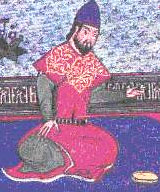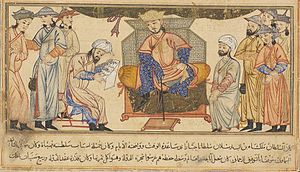Malik-Shah I
| Malik-Shah I | |
|---|---|
Mahmud I | |
| Born | 16 August 1055 Isfahan, Seljuk Empire |
| Died | 19 November 1092 (aged 37) Baghdad, Seljuk Empire |
| Burial | Isfahan |
| Spouse |
|
| Issue |
|
| House | Seljuk |
| Father | Alp Arslan |
| Religion | Sunni Islam |
Malik-Shah I (Persian: ملک شاه), was the third sultan of the Seljuk Empire from 1072 to 1092, under whom the sultanate reached its zenith of power and influence.[3]

During his youth, he spent his time participating in the campaigns of his father
Malik-Shah's death to this day remains under dispute; according to some scholars, he was poisoned by Abbasid caliph al-Muqtadi, while others say that he was poisoned by the supporters of Nizam al-Mulk.
Etymology
Although he was known by several names, he was mostly known as "Malik-Shah", a combination of the Arabic word malik (king) and the Persian word shah (which also means king).
Early life
Malik-Shah was born on 16 August 1055 and spent his youth in
In 1071, Malik-Shah took part in the Syrian campaign of his father, and stayed in Aleppo when his father fought the Byzantine emperor Romanos IV Diogenes at Manzikert.[5] In 1072, Malik-Shah and Nizam al-Mulk accompanied Alp-Arslan during his campaign in Transoxiana against the Karakhanids. However, Alp-Arslan was badly wounded during his expedition, and Malik-Shah shortly took over the army. Alp-Arslan died some days later, and Malik-Shah was declared as the new sultan of the empire.
Reign

War of succession
However, right after Malik-Shah's accession, his uncle
During the battle, the Turks of Malik-Shah's army mutinied against him, but he nevertheless managed to defeat and capture Qavurt.
Warfare with Karakhanids
Malik-Shah then turned his attention towards the Karakhanids, who had after the death of Alp-Arslan invaded
Other wars
In 1074, Malik-Shah ordered the Turkic warlord Arghar to restore what he had destroyed during his raids in the territory of the
Domestic policy and Ismailis
In 1092,
The Sultan had a good relationship with the Shias at large except for the
Death and aftermath
Malik-Shah died on 19 November 1092 while he was hunting. He was most likely poisoned by the caliph or the supporters of Nizam al-Mulk. Under the orders of Terken Khatun, Malik-Shah's body was taken back to Isfahan, where it was buried in a madrasa.[5][24]
Upon his death, the Seljuk Empire fell into chaos, as rival successors and regional governors carved up their empire and waged war against each other. The situation within the Seljuk lands was further complicated by the beginning of the First Crusade, which detached large portions of Syria and Palestine from Muslim control in 1098 and 1099. The success of the First Crusade is at least in part attributable to the political confusion which resulted from Malik-Shah's death.[25]
Family
Malikshah had many wives and concubines and multiple children born from them. Principal wives were:
- Terken Khatun (b. 1053, m. 1065.[26] d. 1094[27]) — daughter of Tamghach Khan Ibrahim[28]
- Dawud (d. 1082)
- Ahmed (1077-1088)
- Mahmud (b. 1087–8)[29]
- Abu'l-Qasim (d. childhood)
- A son (d. childhood, buried in Ray)[30]
- Mah-i Mulk Khatun[31] (m. 1082 to Al-Muqtadi[32])
- Zubayda Khatun (b. 1056[33] d. 1099[33]) — daughter of Yaquti son of Chaghri Beg
- Barkiyaruq[34]
- Gawhar Khatun (m. Mas'ud III of Ghazni)[35][36][37][26]
Concubines:[30]
- Taj al-Din Khatun Safariyya[38] (also known as Bushali,[30] d. 1121, Merv[39])
- Muhammad Tapar
- Ahmad Sanjar[38]
- A son (d. childhood, buried in Ray)[30]
- Ismah Khatun[32] (m. 1109 to Al-Mustazhir)[40][35]
- Unknown mothers:
- Tughril
- Amir Khumarin (an albino)[30]
- Sitara Khatun (m. Garshasp II, son of Ali ibn Faramurz)[41]
- Salkim Khatun[35] (m. Qarin III, son of Shahriyar IV,[42] m. Ali I)[35]
- Safiya Khatun (m. Taj al-Din Abu'l-Fazl Nasr bin Halef, ruler of Sistan)[35]
- A daughter (m. Sultan Shah, son of Qavurt)[35]
- A daughter (m. Ispahbud Taj al-Mulk Mardavij, son of Ali ibn Mardavij)[42]
- Terken Khatun[43] (m. Kara-Khanid Muhammad Arslan Khan (r. 1102 – 1129)
- Rukn al-Din Mahmud Khan (r. 1132-1144), succeeded Sanjar in Khurasan.[26]
- A daughter (m. 1101–02 Abdulaziz bin Omar bin Maza, governor of Bukhara)[35]
Legacy
The 18th century English historian Edward Gibbon wrote of him:
On his father's death the inheritance was disputed by an uncle, a cousin, and a brother: they drew their cimeters, and assembled their followers; and the triple victory of Malek Shah established his own reputation and the right of primogeniture. In every age, and more especially in Asia, the thirst of power has inspired the same passions, and occasioned the same disorders; but, from the long series of civil war, it would not be easy to extract a sentiment more pure and magnanimous than is contained in the saying of the Turkish prince. On the eve of the battle, he performed his devotions at Thous, before the tomb of the Imam Riza. As the sultan rose from the ground, he asked his vizier Nizam, who had knelt beside him, what had been the object of his secret petition: "That your arms may be crowned with victory," was the prudent, and most probably the sincere, answer of the minister. "For my part," replied the generous Malek, "I implored the Lord of Hosts that he would take from me my life and crown, if my brother be more worthy than myself to reign over the Moslems." The favourable judgment of heaven was ratified by the caliph; and for the first time, the sacred title of Commander of the Faithful was communicated to a Barbarian. But this Barbarian, by his personal merit, and the extent of his empire, was the greatest prince of his age.[44]
Personality
Malik-Shah displayed substantial interest in science, art and literature.[45] The Isfahan Observatory or Malikshah Observatory was constructed during his reign, closing shortly after his death in 1092.[46] It was from the work at the observatory that the Jalali Calendar was adopted.[47] He thought highly of the art of architecture as well, as he enjoyed building new and splendid mosques in his capital, Isfahan. He was religiously tolerant which is supported by the fact that during his reign, subjects of the Seljuk Empire enjoyed internal peace and religious tolerance. Malik-Shah also showed lenience towards exquisite poetry as his reign is also memorable for the poetry of Omar Khayyam.[45]
Despite being arguably the most powerful monarch of his era, it is believed that Malik-Shah was unpretentious and modest. The legend has it that during the years that were hugely successful for Seljuks on all fronts, Malik-Shah, overwhelmed by the imperial might of his dynasty, used to climb to the top of a hill and say the following: "Oh Almighty God, I will somehow cope with the problem of hunger, please save me from the threat of abundance".[48]
Malik Shah did not spend as much time on campaign as his prominent predecessor
References
- ^ Henry Melvill Gwatkin (1923). The Cambridge Medieval History: The Eastern Roman empire (717-1453). p. 307.
Malik Shāh was recognised by the Caliph as his successor, and invested with the title of 'Amir-al-Mu'minin
- ^ Massignon 1982, p. 162.
- ISBN 978-1-440-85353-1.
- ^ Gibb, H. A. R. (1960–1985). The Encyclopedia of Islam, vol. 8. Leiden: Brill. p. 70.
- ^ a b c d e f g h i j Durand-Guédy 2012.
- ^ Luther 1985, pp. 895–898.
- ^ Bosworth 1968, p. 61.
- ^ a b Bosworth 1968, p. 88.
- ^ Bosworth 1968, pp. 88–89.
- ^ a b Bosworth 1968, p. 89.
- ^ Bosworth 1968, pp. 90–91.
- ^ Bosworth 2002, p. 179.
- ^ Bosworth 1968, p. 94.
- ^ Minorsky 1958, p. 40.
- ^ Bosworth 1968, p. 95.
- ^ Gibb, H. A. R. (1960–1985). The Encyclopedia of Islam, vol. 8. Leiden: Brill. p. 71.
- ^ Djalali, S. H. Taqizadeh, The Encyclopaedia of Islam, Vol. 2, Ed. B. Lewis, C. Pellat and J. Schacht, (E. J. Brill, 1991), 397-398.
- ^ Purton 2009, p. 184.
- ^ Richards 2002, p. 226.
- ^ Gibb, H. A. R. (1960–1985). The Encyclopedia of Islam, vol. 8. Leiden: Brill. pp. 69–72.
- ^ Gibb, H. A. R. (1960–1985). The Encyclopedia of Islam, vol. 8. Leiden: Brill. p. 72.
- ^ Bosworth 1968, p. 101.
- ^ Stroeva L.V. "The State of the Ismailis in Iran in the XI - XIII centuries". - Publishing House: "Science", 1978. p. 67, 69, 71
- ^ Gibb, H. A. R. (1960–1985). The Encyclopedia of Islam, vol. 7. Leiden: Brill. p. 275.
- ^ Jonathan Riley-Smith, The Oxford History of the Crusades, (Oxford University Press, 2002), 213.
- ^ a b c Lambton 1988, p. 263.
- ISBN 978-0-521-06936-6.
- ^ Lambton 1988, p. 11.
- ^ Lambton 1988, pp. 226–7.
- ^ ISBN 978-1-136-75258-2.
- ISBN 978-1-107-18324-7.
- ^ ISBN 978-1-4798-6679-3.
- ^ ISBN 978-1-134-56835-2.
- ^ Lambton 1988, pp. 227.
- ^ ISSN 1307-9778. Retrieved 2024-01-08.
- ISBN 978-0-521-06936-6.
- ISBN 978-0-7546-6952-4.
- ^ a b Lambton 1988, p. 35.
- ^ Richards 2002, p. 232.
- ^ Lambton 1988, p. 268.
- ^ Lambton 1988, p. 261.
- ^ a b Lambton 1988, p. 262.
- ISBN 978-1-136-95393-4.
- ^ Edward Gibbon, The History of the Decline and Fall of the Roman Empire, New York: The Modern Library, n.d. v. 3, p. 406.
- ^ a b "Malik-Shāh". Encyclopedia Britannica.
- Bibcode:1960oipg.book.....S.
- )
- ^ "in Russian".
- ISBN 978-0-7486-3827-7.
Sources
- ISBN 0-521-06936-X.
- Bosworth, C. Edmund (2002). "GOWHAR ḴĀTUN". Encyclopaedia Iranica, Vol. XI, Fasc. 2. London et al. p. 179.
{{cite encyclopedia}}: CS1 maint: location missing publisher (link) - Bosworth, C. E (1995). The Later Ghaznavids: Splendour and Decay: The Dynasty in Afghanistan and Northern India 1040-1186. Munshiram Manoharlal Publishers Private, Limited. ISBN 9788121505772. Retrieved 17 May 2014.
- Durand-Guédy, David (2012). "MALEKŠĀH". Encyclopaedia Iranica.
- Lambton, A.K.S. (1988). Continuity and Change in Medieval Persia. Bibliotheca Persica. Bibliotheca Persica. ISBN 978-0-88706-133-2.
- Luther, K. A. (1985). "ALP ARSLĀN". Encyclopaedia Iranica, Vol. I, Fasc. 8-9. pp. 895–898.
- Massignon, Louis (1982). The Passion of al-Hallaj, Mystic and Martyr of Islam. Vol. 2. Translated by Mason, Herbert. Princeton University Press.
- Minorsky, Vladimir (1958). A History of Sharvān and Darband in the 10th-11th Centuries. University of Michigan. pp. 1–219. ISBN 978-1-84511-645-3.
- Richards, Donald Sydney (2002). The Annals of the Saljuq Turks: Selections from Al-Kāmil Fīʻl-Taʻrīkh of ʻIzz Al-Dīn Ibn Al-Athīr. Psychology Press. ISBN 0700715762.
- Peacock, Andrew. "SHADDADIDS". Encyclopaedia Iranica.
- Purton, Peter Fraser (2009). A History of the Early Medieval Siege, C. 450-1220. Boydell & Brewer Ltd. ISBN 9781843834489.
